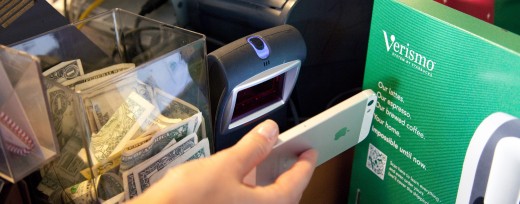
Julius Talvik is co-founder and Chief Innovation Officer of Unison, a brand innovation company in Washington, DC, that develops physical and digital products for companies around the world.
I have a friend who drinks a lot of coffee. So, when Starbucks introduced its wildly popular loyalty app, he was among the first to download it.
He uses the app daily. In fact, he goes out of his way to use it. At his local Safeway, which has a Starbucks, he buys his whole beans separately from his groceries so he can earn rewards stars for the purchase. He’s been known to fetch an empty bag of beans out of the trash to remove the proof of purchase sticker in a quest for more points. This guy loves his Starbucks app.
As my friend demonstrates, customers are quite literally adapting how they live to the brands they love through technology. This is driving increased preference for the brands that do it best. It is as if Starbucks has cracked the code, much as Apple and a handful of others have, that allows the company to modify its customers’ behavior, rather than the other way around.
Starbucks is, in industry parlance, “killing it.” To no one’s surprise, every quick service restaurant under the sun is rushing out its own loyalty app.
It’s hard to imagine a world filled with a different app for each restaurant, but just last week, the Wall Street Journal reported that Starbucks CEO Howard Schultz had reorganized his senior management specifically to put himself more in charge of the company’s digital integration.
So who can say?
It’s more likely that the app free-for-all paradigm we see today will evolve to something more holistic and pervasive in which brands and customers are brought together seamlessly through technology. Rather than have an app for every restaurant, perhaps there will be a single app in which the customer pre-approves specific restaurants and retail outlets to push them data.
Imagine Starbucks or Banana Republic recognizing you by your smart device (with your permission, of course) and be able to beam timely messages to your notifications center as you enter the store.
“Get a triple grande mocha Frappuccino half-off today only!”
“Those jeans you were looking at online yesterday are 40 percent off – men’s section are upstairs.”
This is largely speculation at this point, but the technology exists to make it our reality. Such integration is sure to have greater appeal to customers than individual apps for every retailer or restaurant.
A technological wedding
The successful marriage between Starbucks and its loyalty app is yet another example of the way the virtual and the physical are becoming one. It’s the sort of convergence I touched upon in my recent The Next Web article that discusses the principles of “brand experience”—a new era in which brands are no longer isolated to products or stores, but must become pervasive entities that exist across all channels, physical and digital, at all times.
A commenter on that article, Gunther Sonnenfeld, raised some excellent questions about the thesis, namely: How does experience design and integration actually transform the business itself? How does it change the notion of what a brand actually is? And, with the rise of activist customers in the era of social, how can brands run their businesses with social, financial and ecological transparency?
The advent of pervasive brands and highly integrated physical and digital experiences will have little to no effect on the larger concept of “brand.” Few companies will find themselves needing to adapt to activist customers using social media as a tool to force corporate change.
The brands themselves have established their own standards for social, financial and ecological transparency and it is up to them to carry those brands forward into these new channels.
Starbucks, for instance, long ago positioned itself as a leader in fair trade coffee, as an employee-friendly company that offers health insurance to its baristas, and as a friend of the environment.
A stark contrast
Contrast Starbucks with another company, ExxonMobil. Its SpeedPass app offers functionality virtually identical to Starbucks’—customers can pay, find locations, earn rewards and even play games all from their smartphones.
Brand-wise, ExxonMobil has, shall we say, a reputation for somewhat lesser transparency than Starbucks. The introduction of new technologies and the mere integration of physical spaces with digital applications will do much to alter either brand’s current commitment to social, environmental and financial transparency.
While mobile-social devices have the capability to make businesses more accountable, it doesn’t really change the notion of what a “brand” is. Neither brand would be much altered by social media activists aiming at them, unless of course they do something horrendously off-brand, in which case technology will have little to do with it anyway.
To use another example, the governments deposed during the Arab Spring didn’t have a technology problem, they had branding problem. Technology merely expedited things.
Don’t expect Starbucks to turn away from its carefully nurtured progressiveness, nor ExxonMobil to transform itself into a paragon of transparency simply because of social media. The notion of brand will remain just that, a notion.
A brand is and will remain an aggregation of experiences and emotions associated with a product or a company—an idea “all in the head” of the customer.
If anything, the era of brand experience opens up new possibilities for brands to shift perception in positive ways. Imagine McDonald’s touting new organic menu options or J.Crew promoting new lines of eco-friendly textiles to reshape some longstanding customer perception.
The role of experience designers
We now arrive at the the role experience designers will play in the age of brand experience. In this regard, experience designers will fill a critical role in helping brands to determine how they translate and transfer themselves into a world where the virtual and the physical are one. Part and parcel of that function is a strong strategic investigation, of course, but so too is the goal of creating beauty.
Experience designers will, therefore, need to understand our clients’ social, financial and environmental transparency and to fully synthesize those nuances before creating new brand applications.
At the same time, we will have to approach these practical goals with an aesthetic sensibility that will help these clients stand apart from an ever-growing crowd by creating experiences that are every bit as beautiful as they are functional.
Get the TNW newsletter
Get the most important tech news in your inbox each week.





